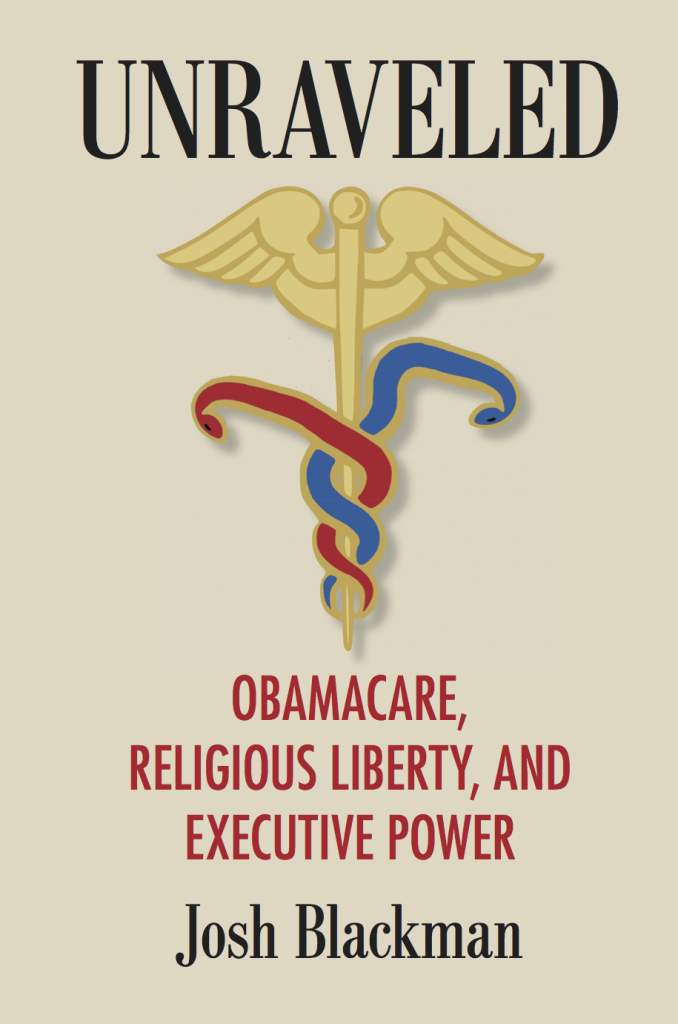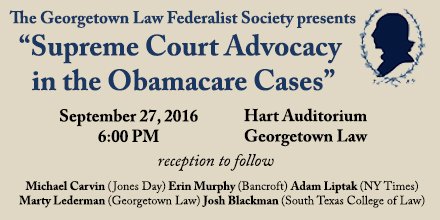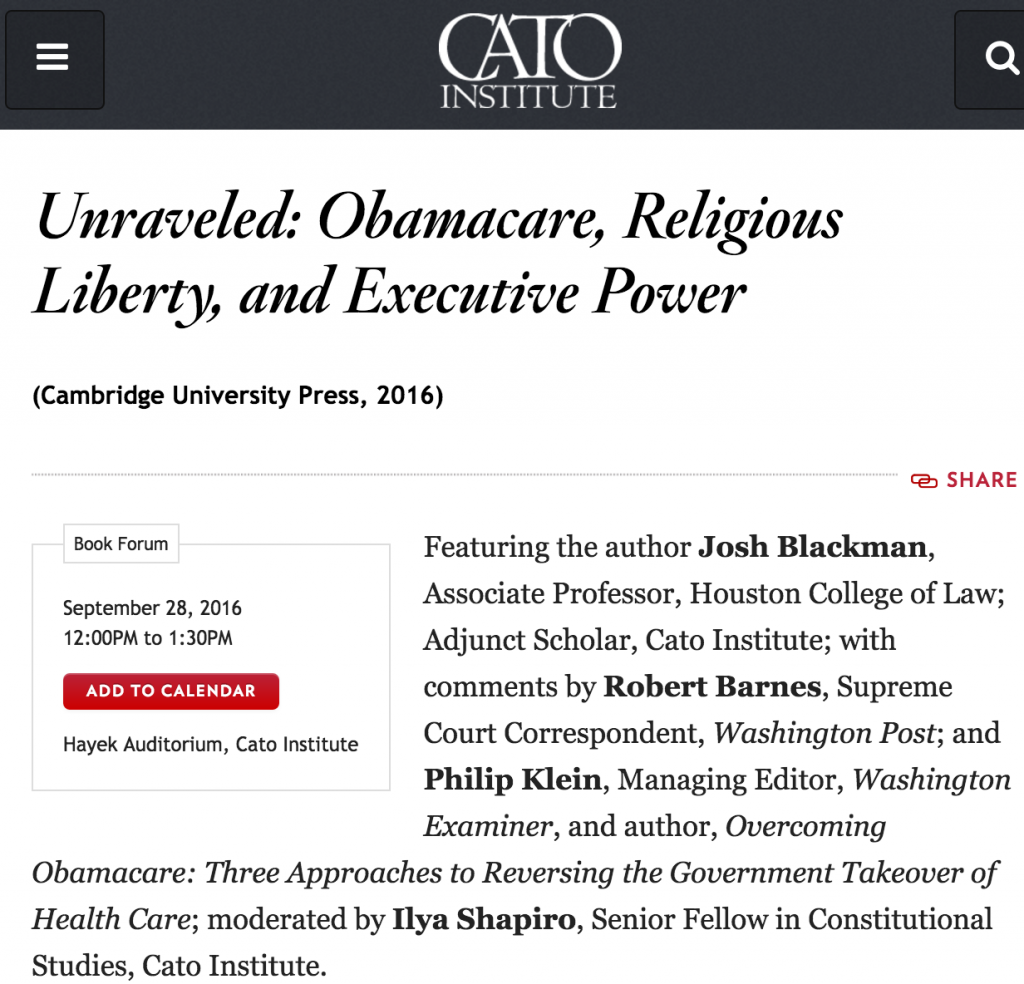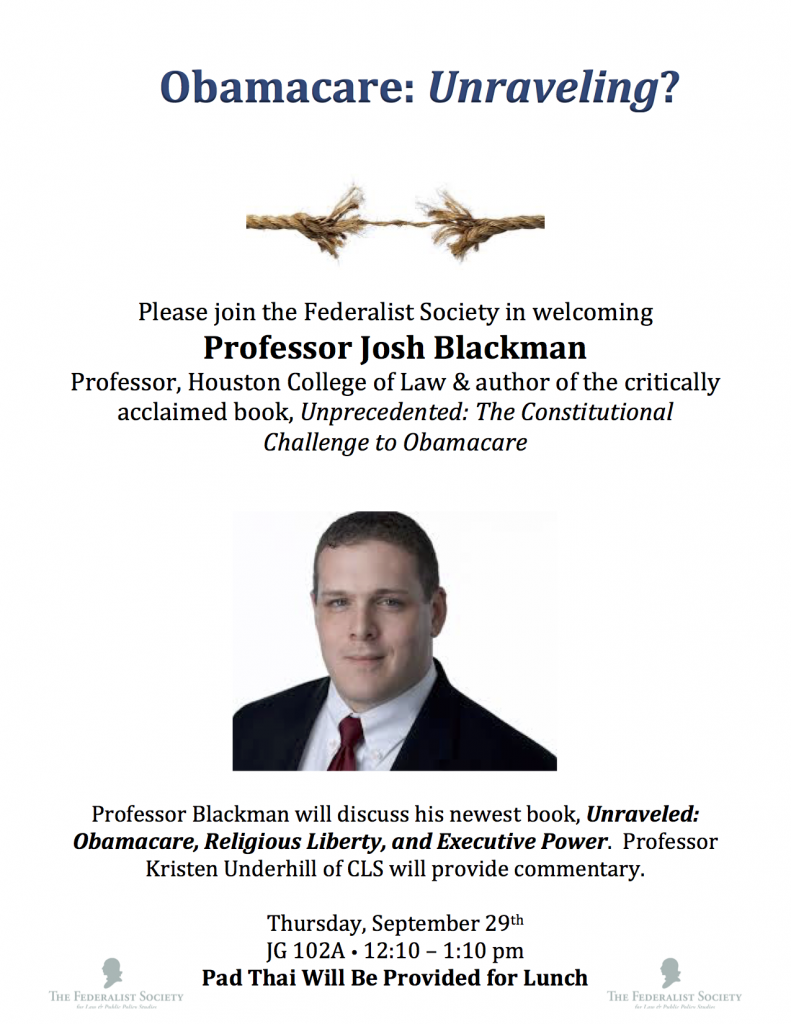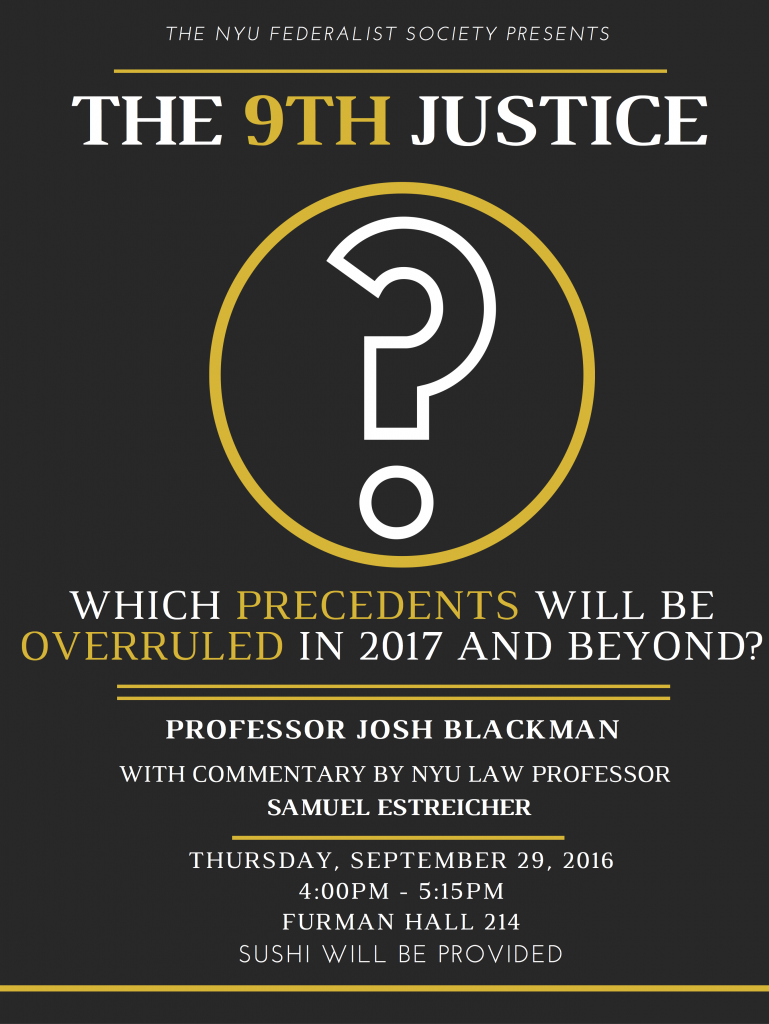Cross-Posted at Volokh Conspiracy
On June 25, 2015, the Supreme Court ruled in King v. Burwell that customers who purchase insurance policies on the federal exchange could receive federal subsidies. Beyond the intricacies of statutory interpretation and administrative law, this case should be studied for the attorneys’ vigorous and effective appellate advocacy. Chapters 21 and 22 of Unraveled provide a step-by-step breakdown of how Mike Carvin of the Jones Day law firm faced off against the Justice Department. Although Carvin did not win the case, he did win the race to the Court.
Speed Bump
In May 2013, Jacqueline Halbig and several other plaintiffs challenged the legality of the IRS Rule that treated federal and state exchanges identically for purposes of subsidies. (I will spare you a rehash of the meaning of “established by the state”). The case, backed by the Competitive Enterprise Institute, was brought by Mike Carvin and his colleagues at Jones Day. Over the next four months, Carvin and the government filed a bevy of dueling motions, the former trying to rush the case, and the latter trying to stall. Despite the pressing nature of the case, Judge Richard W. Roberts did not rule on a single motion.
On September 10, Carvin filed a motion for a preliminary injunction and requested expedited hearing within twenty-one days, noting that the IRS Rule would go into effect in less than three months. Then Carvin rolled the dice. He submitted a “suggestion of reassignment,” asking the court to transfer the case to another judge. This move was risky, as Judge Roberts may have resented the suggestion that he was unfit for the case. Carvin, however, had legitimate grounds for the reassignment. Two months earlier, Judge Roberts was elevated to become Chief Judge of the district, which entailed significant administrative duties. The overworked Roberts finally found a motion he wanted to rule on. (Roberts would resign from the bench under suspicious circumstances in 2015). Three days later, Halbig v. Sebelius was reassigned to Judge Paul L. Friedman, who promptly scheduled oral arguments for October 22, 2013.
Carvin, however, was not content to let the entire case hinge on how the D.C. court would rule. Long before the case was reassigned, the attorneys began searching for a new set of plaintiffs to file an identical suit in the Eastern District of Virginia. There were several purposes for filing the parallel suit. First, the federal district court in Richmond is known as the Rocket Docket, and would yield a decision quickly. Second, and more importantly, the challengers were already looking ahead to the Supreme Court. The Supreme Court is more likely to accept a case for review if the issue has divided the federal courts of appeals. This is known in as a circuit split. By litigating parallel cases in D.C. and Virginia, Carvin speculated that if one rules in his favor and one rules against him, that would make the likelihood of Supreme Court review much greater. This stratagem proved to be prescient, as this is precisely what happened on July 22, 2014 – each court went in a different direction on the same day.
Both cases moved at an uncharacteristically brisk pace. During oral arguments, Carvin recalled that Judge Friedman told everyone, “Look, I’m just the speed bump. You guys want to get out.” He was the first to decide. On January 15, 2014, three months after the case was argued, the court ruled in favor of the government. One month later, Judge Spencer in the Eastern District of Virginia ruled against the parallel case, King. With that, the challengers were off to the races. Judge Spencer’s decision was appealed to the Fourth Circuit Court of Appeals, also in Richmond. Judge Friedman’s decision was appealed to the D.C. Circuit Court of Appeals, which promptly ordered expedited briefing and oral arguments.
Circuit Split
Coincidentally, oral arguments in Halbig v. Sebelius were held on March 25, 2014 – the same day the Supreme Court would hear arguments in Hobby Lobby v. Sebelius. As the proceeding began, D.C. Circuit Judge Thomas B. Griffith joked, “So, I guess this is the group that couldn’t get into First Street this morning.” The Supreme Court, located at One First Street NE, was about half a mile down Constitution Avenue. Joining Judge Griffith on the bench were Judges Harry T. Edwards and A. Raymond Randolph. Two months later, on May 14, 2014, the Fourth Circuit Court of Appeals would hear arguments in King v. Sebelius.
Usually, circuit splits take months, if not years to percolate through the federal courts. On July 24, 2014, within a span of several hours, a circuit split was created in the tax subsidies litigation. At 10:20 am, a divided panel of the D.C. Circuit ruled that the federal government could not provide refundable tax credits on the federal HealthCare.gov. Two hours later, the Fourth Circuit issued a unanimous opinion supporting the IRS Rule.
A lawyer for the challengers told me that the fastest circuit split on record likely wasn’t a “coincidence. Isn’t it far more likely that the 4th Circuit had prepared its ruling and kept it on hold, in anticipation of a likely invalidation from the D.C. panel? By issuing its ruling right after the D.C. court, the 4th Circuit got the last word.” The D.C. Circuit would not have a chance to respond to any of their arguments. I asked a senior Justice Department official how he reacted when the D.C. and Fourth Circuits ruled within hours of each other. He quipped, “Now that was remarkable, wasn’t it?”
Even more remarkable would be the ensuing dogfight between the government and the challengers. Michael Carvin hatched his strategy to get the case to the Supreme Court right away, as the government steadfastly resisted and tried to keep the case far away from the Justices
Dueling Petitions
Flash back to November 21, 2013. As all eyes were focused on the HealthCare.gov crisis, Senate Majority Leader Harry Reid (D-NV) triggered the “nuclear option.” This parliamentary procedure, eliminated the filibuster for all presidential nominations except for the Supreme Court. That move paved the way for Senate Democrats to easily confirm three new Obama nominees to the D.C. Circuit Court of Appeals: Patricia Ann Millett, Nina Pillard, and Robert L. Wilkins. Obama’s only previous nominee to the D.C. Circuit was Sri Srinivasan, who was confirmed unanimously in May 2013. Ironically enough, the Republicans allowed Srinivasan to come up for a vote to prevent Reid from triggering the nuclear option. This détente was short-lived. Before the confirmation of President Obama’s four appointees in 2013, there were three active judges appointed by President Clinton and four active judges appointed by the Presidents Bush. Afterwards the balance was shifted, seven to four. The significance of this realignment would become apparent in the wake of Judge Griffith’s decision in Halbig v. Burwell.
Mike Carvin recognized the changed dynamics. “When we filed in D.C. it was the best circuit in the country,” Carvin told me. “By the time we got up there, it was not the best circuit in the country.” So the goal was simple – appeal the losing King case from the Fourth Circuit to the Supreme Court as soon as possible, before the D.C. Circuit could grant rehearing en banc in Halbig. But the government had just the opposite strategy. The Justice Department wanted to persuade the D.C. Circuit to grant rehearing en banc as soon as possible, while delaying any appeal to the Supreme Court. If the D.C. Circuit sitting en banc ultimately sided with the government, then there would be no more circuit split, and the Supreme Court was less to even take the case. The race to the court was set.
The Fourth Circuit’s decision in King v. Burwell, rejecting the challenger’s reading of Section 36B, was released on July 22, 2014. Under the Supreme Court’s Rule 13, parties have ninety days to file a petition for certiorari. Mike Carvin and his associates at Jones Day took nine days. On July 31, 2014, the attorneys for the challengers filed a forty-three-page brief, urging the Supreme Court to take the case right away. The genesis of the petition began well before either court of appeals had ruled. Carvin, and his associate Yaakov Roth, knew that “the minute the Fourth Circuit decision came out, we’re going to the Supreme Court.” The strategy was to “beat the government going en banc in the D.C. Circuit, and being able to say, ‘there’s already a case pending in the Supreme Court. Why are you guys going to jump?’ ”
The petition made a forceful case for why the Court must take the case right away without waiting. Specifically, “the Treasury has no idea if billions of dollars being spent each month were authorized by Congress, or if these expenditures are illegal.
It was this last argument that resonated the strongest with the Solicitor General’s Office. The petition explained that up to $150 billion would be spent each year until the IRS rule is vacated. A senior official in the Justice Department praised this element of Carvin’s strategy, saying he is a “superb lawyer and a great tactician.” The lawyer added, “there’s a very important reason to intervene earlier rather than later. I think that was an important argument for the Court granting certiorari.”
En Banc
Like the lawyers at Jones Day, attorneys in the Solicitor General’s office had already gamed out how to respond to an anticipated unfavorable ruling. Within an hour of the D.C. Circuit’s ruling in Halbig, before the Fourth Circuit had even released its decision in King, the DOJ announced that it would seek rehearing en banc. The altered composition of the D.C. Circuit certainly made that decision easier. Richard Wolf summed up the issue in USA Today: this case “illustrated what liberals have yearned for and conservatives have feared for six years: President Obama’s judges are having an impact.
On August 1, 2014, the day after the challengers petitioned for certiorari to the Supreme Court, the Department of Justice filed its petition for rehearing en banc before the D.C. Circuit. On August 18, the lawyers at Jones Day opposed the government’s petition for rehearing en banc. The message was simple: “Because the Supreme Court must ultimately resolve the validity of the IRS rule, rehearing would waste both time and effort.” Carvin saw “two ways to win.” First, the D.C. Circuit “denies en banc, at which point Halbig goes to the Supreme Court.” Second, the D.C. Circuit grants en banc, “and we still convince the Supremes to take the case.” In either case, the D.C. Circuit would not have the last word.
Michael Carvin and his team suspected that a majority of the judges on the D.C. Circuit would grant rehearing, thereby vacating Judge Griffith’s panel decision and potentially delaying the Supreme Court’s opportunity to hear the case from Virginia. So he rolled the dice once again and took an unorthodox step to prevent further dilatory tactics by the government.
SCOTUS
Under the Supreme Court’s rules, the government would have to file its brief in opposition to certiorari thirty days after the challenger’s petition for certiorari – that would be on September 3, 2014. However, under the rules, the government could request an extension of up to sixty days. Usually these requests for an extension are granted automatically by the Clerk’s office. Carvin worried that the D.C. Circuit may take this additional two-month window to grant rehearing and vacate Judge Griffiths decision. So on August 6, 2014, Carvin sent a letter to the Clerk of the Supreme Court, Scott H. Harris. “I request that any application by [the government] for an extension of that time be submitted to the full Court for consideration.” Carvin explained that “this case involves a matter of urgent public importance and petitioners there- fore oppose any attempt to delay its resolution.” In other words, the letter asked for the full Court – and presumably five Justices – to vote before an extension could be granted.
As expected, on August 27, 2014 – one week before the deadline – Solicitor General Verrilli filed a letter with the Clerk requesting a thirty-day extension. The next day, Carvin fired away a final request to the Court, explaining that the solicitor general’s arguments for the “last-minute application … are meritless.” On September 2, 2014, Mike Carvin’s phone rang. Scott Harris, the clerk of the Court said he was granting the government’s extension after he had talked to the Justices. Harris relayed that it took a while to discuss and figure out what to do, because this issue had seldom arisen. The clerk noted that any future requests for extension by the government would be looked on with disfavor.
On September 4 – two days after the Supreme Court granted the thirty-day extension – the D.C. Circuit granted rehearing en banc. Perhaps the Judges viewed the decision to grant the extension as a signal on the shadow docket that the Justices weren’t in a hury. Now, Judge Griffith’s opinion was vacated and arguments were set for December 17.
On October 3, 2014, as scheduled, Solicitor General Verrilli filed his brief with the Supreme Court opposing the petition for certiorari. The argument was simple: because there is no longer a circuit split, there is no reason for the Supreme Court to get involved. This was not an argument he could have made had the brief been filed a month earlier. Eleven days later, Carvin and his associates would file one last plea to the Supreme Court, urging the Justices to “put these challenges to rest.” They charged that the government’s attempt to keep the case away from the Court was “irresponsible” and “out of touch with reality.”
After this lengthy dogfight, the challengers prevailed. On Friday, November 7, 2014, at least four Justices voted to grant certiorari. They did not think much of giving the full D.C. Circuit an opportunity to hear the case.
On November 10, the Jones Day attorneys cheerfully filed a motion with the D.C. Circuit to hold Halbig v. Burwell in abeyance pending the resolution of King v. Burwell. The motion noted, “The Supreme Court’s resolution of King will directly control this case.” Two days later, the court ordered Halbig v. Burwell to be removed from the court’s calendar and held in abeyance pending King v. Burwell. The eleven judges of the DC Circuit would not have another shot at the case. This issue would now be resolved by the Justices. Seven months later, the Court–by a vote of 6-3–ruled for the government. At least one of the Justices who ruled against the challengers also voted to hear the case without the benefit of en banc review.
—
Josh Blackman is a constitutional law professor at the Houston College of Law, and the author of Unraveled: Obamacare, Religious Liberty, and Executive Power (Cambridge University Press, 2016).
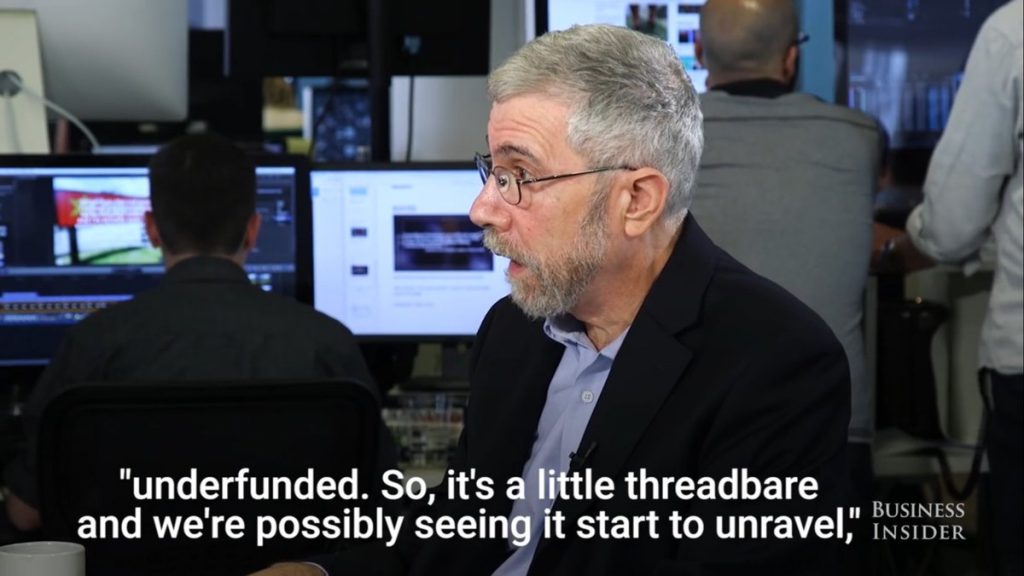 I couldn’t have put it better myself!
I couldn’t have put it better myself!